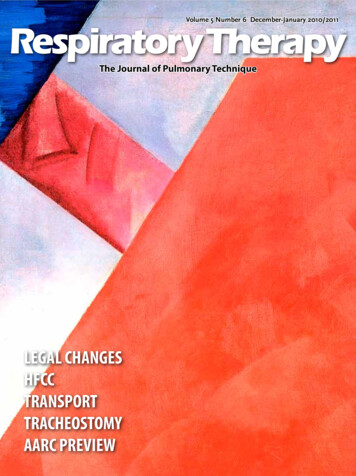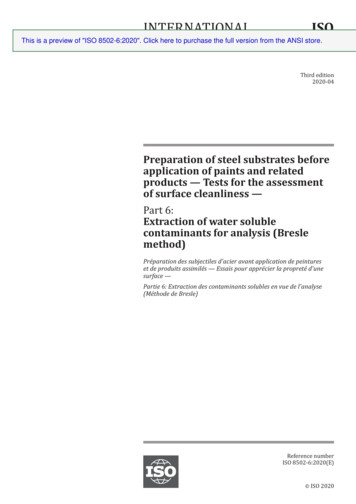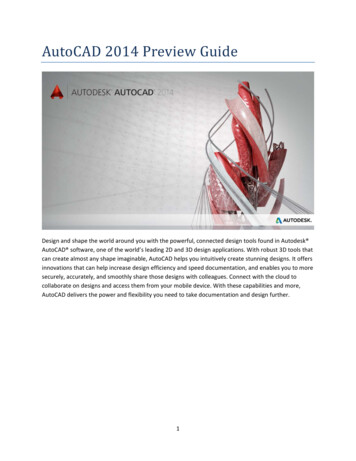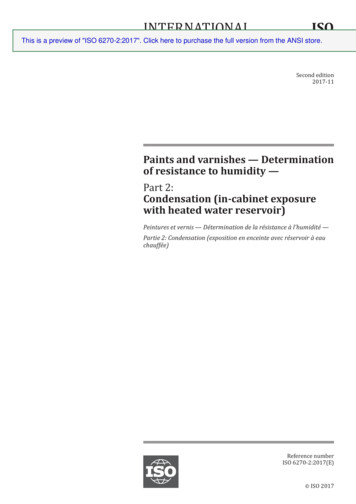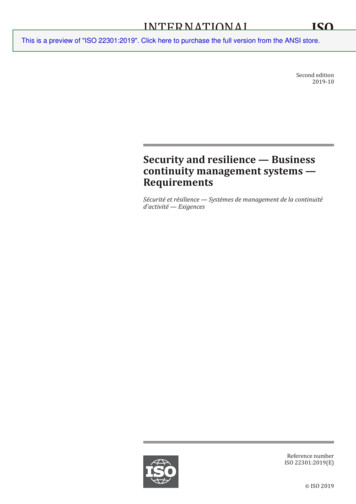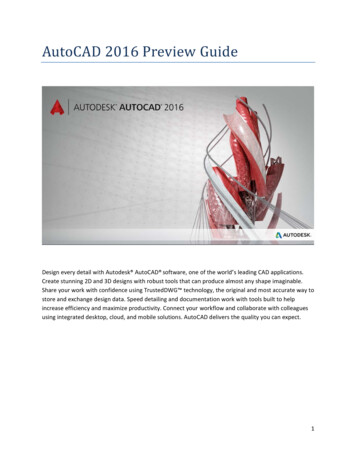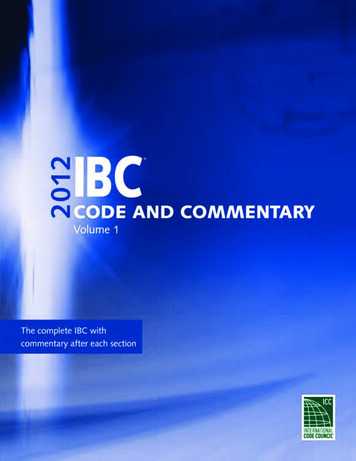
Transcription
This is a preview of "ICC IBC-Vol1-2012 Co.". Click here to purchase the full version from the ANSI store.2012IBC CODE AND COMMENTARYVolume 1
This is a preview of "ICC IBC-Vol1-2012 Co.". Click here to purchase the full version from the ANSI store.2012 International Building Code CommentaryFirst Printing: September 2011ISBN:978-1-60983-062-5 (soft-cover edition)COPYRIGHT 2011byINTERNATIONAL CODE COUNCIL, INC.ALL RIGHTS RESERVED. This 2012 International Building Code Commentary—Volume I is a copyrighted work owned bythe International Code Council, Inc. Without advance written permission from the copyright owner, no part of this book may bereproduced, distributed or transmitted in any form or by any means, including, without limitation, electronic, optical or mechanical means (by way of example, and not limitation, photocopying, or recording by or in an information storage retrieval system).For information on permission to copy material exceeding fair use, please contact: Publications, 4051 West Flossmoor Road,Country Club Hills, IL 60478-5795. Phone 1-888-ICC-SAFE (422-7233).Trademarks: “International Code Council,” the “International Code Council” logo and the “International Building Code” aretrademarks of the International Code Council, Inc.PRINTED IN THE U.S.A.
This is a preview of "ICC IBC-Vol1-2012 Co.". Click here to purchase the full version from the ANSI store.PREFACEThe principal purpose of the Commentary is to provide a basic volume of knowledge and facts relating to building constructionas it pertains to the regulations set forth in the 2012 International Building Code. The person who is serious about effectivelydesigning, constructing and regulating buildings and structures will find the Commentary to be a reliable data source and reference to almost all components of the built environment.As a follow-up to the International Building Code, we offer a companion document, the International Building Code Commentary—Volume I. Volume I covers Chapters 1 through 15 of the 2012 International Building Code. The basic appeal of theCommentary is thus: it provides in a small package and at reasonable cost thorough coverage of many issues likely to be dealtwith when using the International Building Code — and then supplements that coverage with historical and technical background. Reference lists, information sources and bibliographies are also included.Throughout all of this, effort has been made to keep the vast quantity of material accessible and its method of presentationuseful. With a comprehensive yet concise summary of each section, the Commentary provides a convenient reference for regulations applicable to the construction of buildings and structures. In the chapters that follow, discussions focus on the full meaningand implications of the code text. Guidelines suggest the most effective method of application, and the consequences of notadhering to the code text. Illustrations are provided to aid understanding; they do not necessarily illustrate the only methods ofachieving code compliance.The format of the Commentary includes the full text of each section, table and figure in the code, followed immediately by thecommentary applicable to that text. At the time of printing, the Commentary reflects the most up-to-date text of the 2012 International Building Code. As stated in the preface to the International Building Code, the content of sections in the code whichbegin with a letter designation (i.e., Section [F]307.1) are maintained by another code development committee. Each section’snarrative includes a statement of its objective and intent, and usually includes a discussion about why the requirement commandsthe conditions set forth. Code text and commentary text are easily distinguished from each other. All code text is shown as itappears in the International Building Code, and all commentary is indented below the code text and begins with the symbol .Readers should note that the Commentary is to be used in conjunction with the International Building Code and not as a substitute for the code. The Commentary is advisory only; the code official alone possesses the authority and responsibility for interpreting the code.Comments and recommendations are encouraged, for through your input, we can improve future editions. Please direct yourcomments to the Codes and Standards Development Department at the Chicago District Office.The International Code Council would like to extend its thanks to the following individuals for their contributions to the technical content of this commentary:Chris MarionGregory CahaninJeff TubbsDavid CooperRebecca QuinnDave CollinsJoann SurmarVickie LovellJames MilkeJohn ValiulisRichard WalkeMarcelo HirschlerDave AdamsEdward KeithZeno MartinPhillip SamblanetJason Thompson2012 INTERNATIONAL BUILDING CODE COMMENTARYiii
This is a preview of "ICC IBC-Vol1-2012 Co.". Click here to purchase the full version from the ANSI store.iv2012 INTERNATIONAL BUILDING CODE COMMENTARY
This is a preview of "ICC IBC-Vol1-2012 Co.". Click here to purchase the full version from the ANSI store.TABLE OF CONTENTSCHAPTER 1 SCOPE AND ADMINISTRATION . . . . . . . . . . . . . . . . . . . . . . . . . . . . . . . . . . . . . . . . . . . . . . . . . . 1-1 – 1-26PART 1—SCOPE AND APPLICATION. . . . . . . . . . . . . . . . . . . . . . . . . . . . . . . . . . . . . . . . . . . . . . . . . . . . . . . . . . . . 1-1 – 1-5PART 2—ADMINISTRATION AND ENFORCEMENT . . . . . . . . . . . . . . . . . . . . . . . . . . . . . . . . . . . . . . . . . . . . . 1-5 – 1-26CHAPTER 2DEFINITIONS . . . . . . . . . . . . . . . . . . . . . . . . . . . . . . . . . . . . . . . . . . . . . . . . . . . . . . . . . . . . . . . . . 2-1 – 2-106CHAPTER 3USE AND OCCUPANCY CLASSIFICATION . . . . . . . . . . . . . . . . . . . . . . . . . . . . . . . . . . . . . . . 3-1 – 3-42CHAPTER 4SPECIAL DETAILED REQUIREMENTS BASED ON USE AND OCCUPANCY . . . . . . . . 4-1 – 4-138CHAPTER 5GENERAL BUILDING HEIGHTS AND AREAS. . . . . . . . . . . . . . . . . . . . . . . . . . . . . . . . . . . . . 5-1 – 5-54CHAPTER 6TYPES OF CONSTRUCTION . . . . . . . . . . . . . . . . . . . . . . . . . . . . . . . . . . . . . . . . . . . . . . . . . . . . 6-1 – 6-18CHAPTER 7FIRE AND SMOKE PROTECTION FEATURES . . . . . . . . . . . . . . . . . . . . . . . . . . . . . . . . . . . 7-1 – 7-198CHAPTER 8INTERIOR FINISHES . . . . . . . . . . . . . . . . . . . . . . . . . . . . . . . . . . . . . . . . . . . . . . . . . . . . . . . . . . . 8-1 – 8-18CHAPTER 9FIRE PROTECTION SYSTEMS . . . . . . . . . . . . . . . . . . . . . . . . . . . . . . . . . . . . . . . . . . . . . . . . . 9-1 – 9-128CHAPTER 10MEANS OF EGRESS . . . . . . . . . . . . . . . . . . . . . . . . . . . . . . . . . . . . . . . . . . . . . . . . . . . . . . . . . 10-1 – 10-198CHAPTER 11ACCESSIBILITY . . . . . . . . . . . . . . . . . . . . . . . . . . . . . . . . . . . . . . . . . . . . . . . . . . . . . . . . . . . . . 11-1 – 11-66CHAPTER 12INTERIOR ENVIRONMENT . . . . . . . . . . . . . . . . . . . . . . . . . . . . . . . . . . . . . . . . . . . . . . . . . . . 12-1 – 12-18CHAPTER 13ENERGY EFFICIENCY. . . . . . . . . . . . . . . . . . . . . . . . . . . . . . . . . . . . . . . . . . . . . . . . . . . . . . . . . 13-1 – 13-2CHAPTER 14EXTERIOR WALLS. . . . . . . . . . . . . . . . . . . . . . . . . . . . . . . . . . . . . . . . . . . . . . . . . . . . . . . . . . . 14-1 – 14-48CHAPTER 15ROOF ASSEMBLIES AND ROOFTOP STRUCTURES . . . . . . . . . . . . . . . . . . . . . . . . . . . . .15-1 – 15-40INDEX. . . . . . . . . . . . . . . . . . . . . . . . . . . . . . . . . . . . . . . . . . . . . . . . . . . . . . . . . . . . . . . . . . . . INDEX-1 – INDEX-382012 INTERNATIONAL BUILDING CODE COMMENTARYv
This is a preview of "ICC IBC-Vol1-2012 Co.". Click here to purchase the full version from the ANSI store.vi2012 INTERNATIONAL BUILDING CODE COMMENTARY
This is a preview of "ICC IBC-Vol1-2012 Co.". Click here to purchase the full version from the ANSI store.Part 1—Scope and ApplicationChapter 1:Scope and AdministrationGeneral CommentsThis chapter contains provisions for the application,enforcement and administration of subsequent requirements of the code. In addition to establishing the scopeof the code, Chapter 1 identifies which buildings andstructures come under its purview. Section 101addresses the scope of the code and references theother International Codes that are mentioned elsewhere in the code. Section 102 establishes the applicability of the code and addresses existing structures.Section 103 establishes the department of buildingsafety and the appointment of department personnel.Section 104 outlines the duties and authority of thebuilding official with regard to permits, inspections andright of entry. It also establishes the authority of thebuilding official to approve alternative materials, usedmaterials and modifications. Section 105 states whenpermits are required and establishes the procedures forthe review of applications and the issuance of permits.Section 106 provides requirements for posting live loadsgreater than 50 pounds per square foot (2394 Pa) (psf).Section 107 describes the information that must beincluded on the construction documents submitted withthe application. Section 108 authorizes the building official to issue permits for temporary structures and uses.Section 109 establishes requirements for a fee schedule. Section 110 includes inspection duties of the building official or an inspection agency that has beenapproved by the building official. Provisions for the issuance of certificates of occupancy are detailed in Section111. Section 112 gives the building official the authorityto approve utility connections. Section 113 establishesthe board of appeals and the criteria for making applications for appeal. Administrative provisions for violationsare addressed in Section 114, including provisions forunlawful acts, violation notices, prosecution and penalties. Section 115 describes procedures for stop workorders. Section 116 establishes the criteria for unsafestructures and equipment and the procedures to be followed by the building official for abatement and for notification to the responsible party.Each state’s building code enabling legislation, whichis grounded within the police power of the state, is thesource of all authority to enact building codes. In termsof how it is used, police power is the power of the stateto legislate for the general welfare of its citizens. Thispower enables passage of such laws as building codes.If the state legislature has limited this power in any way,2012 INTERNATIONAL BUILDING CODE COMMENTARYthe municipality may not exceed these limitations. Whilethe municipality may not further delegate its policepower (e.g., by delegating the burden of determiningcode compliance to the building owner, contractor orarchitect), it may turn over the administration of thebuilding code to a municipal official, such as a buildingofficial, provided that sufficient criteria are given toestablish clearly the basis for decisions as to whether ornot a proposed building conforms to the code.Chapter 1 is largely concerned with maintaining “dueprocess of law” in enforcing the building performancecriteria contained in the body of the code. Only throughcareful observation of the administrative provisions canthe building official reasonably hope to demonstrate that“equal protection under the law” has been provided.While it is generally assumed that the administrationand enforcement section of a code is geared toward abuilding official, this is not entirely true. The provisionsalso establish the rights and privileges of the designprofessional, contractor and building owner. The position of the building official is merely to review the proposed and completed work and to determine if theconstruction conforms to the code requirements. Thedesign professional is responsible for the design of asafe structure. The contractor is responsible for constructing the structure in compliance with the plans.During the course of construction, the building officialreviews the activity to ascertain that the spirit and intentof the law are being met and that the safety, health andwelfare of the public will be protected. As a public servant, the building official enforces the code in an unbiased, proper manner. Every individual is guaranteedequal enforcement of the provisions of the code. Furthermore, design professionals, contractors and building owners have the right of due process for anyrequirement in the code.PurposeA building code, as with any other code, is intended tobe adopted as a legally enforceable document to safeguard health, safety, property and public welfare. Abuilding code cannot be effective without adequate provisions for its administration and enforcement. The official charged with the administration and enforcement ofbuilding regulations has a great responsibility, and withthis responsibility goes authority. No matter howdetailed the building code may be, the building officialmust, to some extent, exercise his or her own judge1-1
This is a preview of "ICC IBC-Vol1-2012 Co.". Click here to purchase the full version from the ANSI store.SCOPE AND ADMINISTRATIONment in determining code compliance. The building official has the responsibility to establish that the homes inwhich the citizens of the community reside and thebuildings in which they work are designed and constructed to be structurally stable with adequate meansof egress, light and ventilation and to provide a minimum acceptable level of protection to life and propertyfrom fire.Chapter 1 contains two parts. Part 1, Scope andApplication, contains all issues related to the scope andintent of the code, as well as the applicability of thiscode relative to other standards and laws that mightalso be applicable on a given building project, such asfederal or state. Part 2, Administration and Enforcement, contains all
This is a preview of "ICC IBC-Vol1-2012 Co.". Click here to purchase the full version from the ANSI store. SCOPE AND ADMINISTRATION 1-2 2012 INTERNATIONAL BUILDING CODE COMMENTARY SECTION 101 GENERAL [A] 101.1 Title. These regulations shall be known as the Building Code of [NAME OF JURISDICTION], hereinafter referred to as “this code.” The purpose of this section is to
